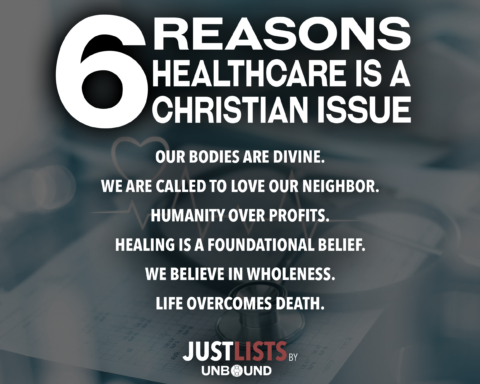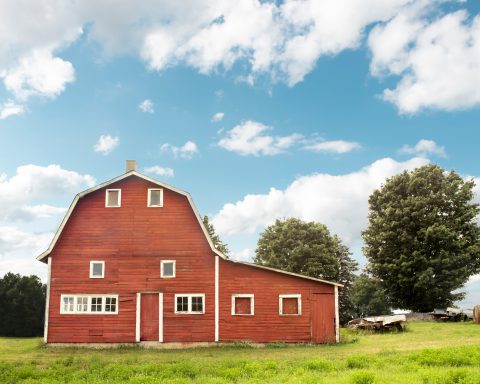Building Community Together in the Health & Faith Cooperative
Editor’s Note: In Defending the Common Good, we cannot forget the crucial role of healthcare, nor the need for health providers to find new ways of relating to communities. This article does not do cost/benefit analysis, but instead addresses the creativity and mission that can change our paradigms of interaction—even in the context of an internationally renowned part of the medical-industrial complex.

In the not-so-distant past, it could be difficult to tell the difference between treating a disease and treating only its symptoms. Although modern hospitals work very hard to get real positive outcomes for their patients, in some ways the U.S. healthcare system has only been treating the “symptoms” of the ways in which the population’s well-being is at risk. Our hospital network seeks to change this approach.
In order to increase a population’s well-being, it is not enough to treat sick individuals at inpatient facilities; rather, we are quickly learning that preventive care is the key to improving population health outcomes–and to cutting healthcare costs nationwide. In order to live out our mission of care most effectively, we in the healthcare industry must systematically build health engagement in our communities–which facilitates such preventive care–and we are trying to do that here, at the Cleveland Clinic.
There are many reasons why this is a challenge. The Cleveland Clinic is a large medical institution with over 3500 inpatient beds in more than a dozen hospitals, and more than 50,000 employees in Northeast Ohio alone. As such, the barriers – both tangible and intangible – are many. It is a large, foreboding place. The main campus alone takes up over 40 buildings on more than 160 acres. Its labyrinthine tunnels and bridges (a must for snowy climes) can render natural orienteering points such as streets and daylight useless. Simply having to navigate the campus can be daunting. Furthermore, the signature buildings are gleaming and new, humming with traffic and people from literally all over the world. Instead of being a part of home, it can feel more like an international airport or mall – at least, until you notice the folks in their flimsy hospital gowns in wheelchairs or pushing their IV poles.
As is the case for most urban, academic, nonprofit research hospitals, the Clinic’s main campus is surrounded by neighborhoods which have increasingly suffered from depopulation over the past several decades. Like many similar institutions, the Clinic is often perceived as part of the problem, buying up surrounding properties in order to expand its footprint. (On the other hand, people are often reluctant to buy residential property near hospitals for myriad reasons). At any rate, the Clinic has long struggled with its “ivory tower” image. Yet, Cleveland Clinic genuinely longs to be a good neighbor.
In the summer of 2015, in an effort to increase trust and communication between the surrounding community and the Clinic, a few like-minded individuals from Spiritual Care, the Cancer Center, Government and Community Relations, and the Pulmonary Institute decided to form an informal network between local clergy (of all faiths) and the Clinic for the purpose of developing more personal connections, in order to work on common goals related to the health and wholeness of the greater community. Today, we call this network the Health & Faith Cooperative.
___________________________________________
Our mission statement:
“To be a force to transform the wellbeing of our communities through
education, resources, trust, and mutual support.”
___________________________________________

With Local Faith Leaders and Clinic Employees
When we began, we were keenly aware of the community’s perception (rightly or wrongly) that the Clinic ‘never does anything without its own pre-formed agenda’. Therefore we worked hard to clarify that we wanted the mission and agenda of this new network to be formed by the group, together–not unilaterally by the Clinic. Our first meeting, on August 20, 2015, brought 20 faith leaders to the “round-tables-and-breakfast” session, where we listened to what actions the clergy thought were needed . Common themes emerged quickly: building trust and connection, networking for education and information about health, helping people in their congregations and communities more closely connect health, faith, and overall wellbeing.
We rotate among locations – east side, west side and south side – in order to insure representation. (The north side of downtown Cleveland is called Lake Erie–not a suitable meeting place!) By the second meeting, we had a plan. With excellent facilitation from our own Global Leadership and Learning Institute guide, we worked through an iterative process to form our mission statement: “To be a force to transform the wellbeing of our communities through education, resources, trust, and mutual support.”
___________________________________________
We have set a goal of developing a Speakers Bureau, but we are also committed to a Listeners Bureau, whereby congregations and communities can request representatives from the Clinic to engage in either.
___________________________________________
Throughout 2016 and into 2017, our meetings have included topical discussions with local experts, such as gun violence, infant mortality, advance directives for healthcare, the opioid epidemic in Northeast Ohio, and more. Items of mutual concern that have emerged in discussions are health disparities and “food deserts” in Cleveland, low trust around End-of-Life conversations among minority communities, and the need for community education which is engaged and mutual rather than paternalistic. We have set a goal of developing a Speakers Bureau, but we are also committed to a Listeners Bureau, whereby congregations and communities can request representatives from the Clinic to engage in either.
We have tried to tread softly on the issue of group email and communication, wanting to stay connected and provide easy access to each other without sliding down the slippery bureaucratic slope of simply regurgitating announcements and forwarding emails. There are many things to attract our passion and we work to choose carefully what we will do with limited time and resources.
Many members of our team have felt all along—for reasons beyond our immediate understanding– that the timing was just somehow right for us to begin this effort, and that we should “watch and wait” for more direction to evolve naturally. In the spring of this year, we invited a colleague and friend of mine, Rev. Dr. Gary Gunderson, now of Wake Forest Baptist Medical Center and a former staffer for the Carter Center – to come and speak to our group. Gary, a friend for over 35 years, has always been a social justice and faith “thought leader” and sower of seeds. Between his jobs at the Carter Center and at Wake Forest, he was a VP for Mission at Bon Secours Health System in Memphis, where he formed partnerships with hundreds of congregations to support better health outcomes, with measurable outcomes backed by research (the ‘keys to the kingdom’ in any healthcare setting).
Gary and two of his colleagues came to the Clinic in April to present to the Health and Faith Cooperative (H+FC) about their Wake Forest work, where they had discovered a slightly different model worked better. Utilizing existing employees who lived near the hospital (who were already trusted leaders in their communities), they instituted a semi-formal role, including a small stipend, for environmental service workers to function as community liaisons. This creative thinking sparked a lot of hope within the H+FC and spilled over to members of other groups within the Clinic – the Ethics Committee, the Office of Patient Experience and more. There is energy here to see us try some similarly creative approaches to community partnering.
As population health becomes a bigger focus for healthcare institutions, we are hopeful that our small but faithful cooperative will be put to use and will help focus our passions and efforts in measureable ways. As we prepare to celebrate our second anniversary, we hope the relationships we have built so far will undergird us and allow us to start really becoming the “force to transform the wellbeing of our communities” that we envisioned all along.
AUTHOR BIO: Rev. Amy Greene is Director of Spiritual Care at the Cleveland Clinic and chair-elect of the Board of Directors of the Association for Clinical Pastoral Education, Inc. She has an M.Div. from Union Theological Seminary in New York City (1986) and a doctorate in ministry from Ecumenical Theological Seminary in Detroit. She was an ACPE supervisor in Atlanta, her home town, before joining the Cleveland Clinic in 2007. She is ordained by the Alliance of Baptists, wife of Thomas Reuter for 33 years, and the mother of two grown sons. She gets to see Lake Erie every morning and evening, right outside her front door.






Unbound Social